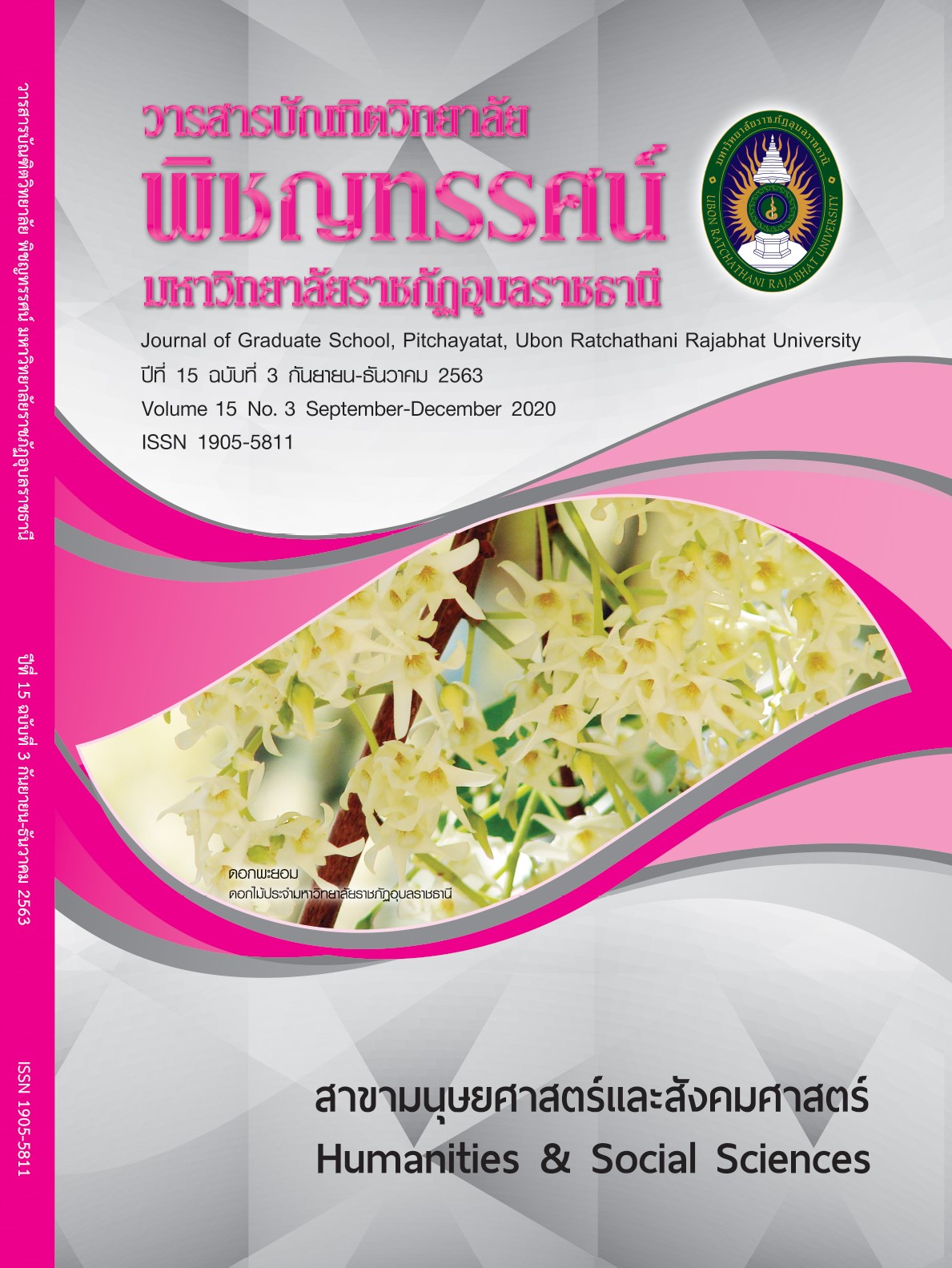การพัฒนารูปแบบองค์การแห่งการเรียนรู้ในโรงเรียนขยายโอกาสทางการศึกษา สังกัดสำนักงานเขตพื้นที่การศึกษาประถมศึกษานครศรีธรรมราช เขต 2
คำสำคัญ:
การพัฒนารูปแบบ, องค์การแห่งการเรียนรู้, โรงเรียนขยายโอกาสทางการศึกษาบทคัดย่อ
การวิจัยนี้มีวัตถุประสงค์เพื่อ 1) ศึกษาสภาพความเป็นองค์การแห่งการเรียนรู้ 2) วิเคราะห์องค์ประกอบหลักรูปแบบองค์การแห่งการเรียนรู้ 3) พัฒนารูปแบบองค์การแห่งการเรียนรู้ และ 4) ตรวจสอบรูปแบบองค์การแห่งการเรียนรู้ ในโรงเรียนขยายโอกาสทางการศึกษา สังกัดสำนักงานเขตพื้นที่การศึกษาประถมศึกษานครศรีธรรมราช เขต 2 ใช้ระเบียบวิธีวิจัยแบบผสานวิธี ตัวอย่างในการวิจัย คือ ผู้บริหารและครูโรงเรียนขยายโอกาสทางการศึกษา สังกัดสำนักงานเขตพื้นที่การศึกษาประถมศึกษานครศรีธรรมราช เขต 2 จำนวน 474 คน ทำการสุ่มอย่างง่าย เครื่องมือที่ใช้ ได้แก่ แบบวิเคราะห์เอกสาร แบบสัมภาษณ์ แบบสอบถาม แบบสัมมนาอิงผู้เชี่ยวชาญ สถิติที่ใช้ ได้แก่ ค่าเฉลี่ย ส่วนเบี่ยงเบนมาตรฐาน การวิเคราะห์องค์ประกอบ และการวิเคราะห์เนื้อหา
ผลการวิจัยพบว่า
- สภาพความเป็นองค์การแห่งการเรียนรู้ในโรงเรียนขยายโอกาสทางการศึกษา สังกัดสำนักงานเขต
พื้นที่การศึกษาประถมศึกษานครศรีธรรมราช เขต 2 โดยภาพรวมอยู่ในระดับมาก
- องค์ประกอบหลักรูปแบบองค์การแห่งการเรียนรู้ มี 7 องค์ประกอบ คือ 1) การวางเป้าหมายในอนาคต มี 2 องค์ประกอบย่อย คือ การกำหนดวิสัยทัศน์ พันธกิจ และเป้าหมาย และกลยุทธ์การบริหารจัดการองค์การ 2) การพัฒนาทรัพยากรมนุษย์ มี 3 องค์ประกอบย่อย คือ การเรียนรู้ วินัยในการเรียนรู้ และการจัดการความรู้ 3) การมีโครงสร้างองค์การที่เหมาะสม มี 2 องค์ประกอบย่อย คือ การจัดโครงสร้างองค์การ และการมอบหมายงานและการติดต่อประสานงาน 4) เทคโนโลยีสารสนเทศ มี 2 องค์ประกอบย่อย คือ เทคโนโลยีเพื่อการเรียนรู้ และเทคโนโลยีเพื่อการจัดการความรู้ 5) การตรวจสอบกระบวนการทำงาน มี 2 องค์ประกอบย่อย คือ การติดตามการทำงาน และการประเมินผลการทำงาน 6) ความเป็นผู้นำของผู้บริหาร มี 2 องค์ประกอบย่อย คือ ผู้นำแบบเพื่อนร่วมงาน และผู้นำการเปลี่ยนแปลง และ7) การวิเคราะห์สภาพแวดล้อม มี 2 องค์ประกอบย่อย คือ การวิเคราะห์สภาพแวดล้อมภายใน และการวิเคราะห์สภาพแวดล้อมภายนอก
- รูปแบบองค์การแห่งการเรียนรู้ มี 7 ส่วน คือ ชื่อรูปแบบ ความเป็นมาของรูปแบบ วัตถุประสงค์ของ
รูปแบบ หลักการของรูปแบบ องค์ประกอบหลักของรูปแบบ แนวทางการประเมินรูปแบบ และเงื่อนไขความสำเร็จของรูปแบบ
- ผลการตรวจสอบรูปแบบองค์การแห่งการเรียนรู้ ผู้เชี่ยวชาญลงความเห็นว่ารูปแบบมีความถูกต้อง
ความเหมาะสม ความเป็นไปได้ และความเป็นประโยชน์อยู่ในระดับมาก
เอกสารอ้างอิง
เอเชีย ฉบับสังคมศาสตร์และมนุษย์ศาสตร์. 4, 2 (2557): 53-62.
เขตพื้นที่การศึกษาประถมศึกษานครศรีธรรมราช เขต 2, สำนักงาน. แผนปฏิบัติงานประจำปีงบประมาณพ.ศ. 2561. สำนักงานเขตพื้นที่การศึกษาประถมศึกษานครศรีธรรมราช เขต 2: จังหวัดนครศรีธรรมราช, 2561.
คณะกรรมการการศึกษาขั้นพื้นฐาน, สำนักงาน. แผนพัฒนาการบริหารการจัดการเพื่อสร้างความเข้มแข็ง และยกระดับคุณภาพการศึกษาโรงเรียนขนาดเล็ก. กรุงเทพฯ: โรงพิมพ์องค์การรับส่งสินค้าและพัสดุภัณฑ์
(ร.ส.พ.), 2549.
จันทรา ส่งศรี. “รูปแบบการพัฒนาวัฒนธรรมองค์การที่เน้นความเป็นองค์การแห่งการเรียนรู้ของวิทยาลัยอาชีวศึกษา,”วารสารวิชาการมหาวิทยาลัยอีสเทิร์นเอเชีย ฉบับสังคมศาสตร์และมนุษย์ศาสตร์. 4, 2 (2557): 63-73.
นฤมล สายะบุตร และประกอบ คุณารักษ์. “รูปแบบการจัดการความรู้สู่การเป็นองค์การแห่งการเรียนรู้ในโรงเรียนสังกัดมูลนิธิแห่งสภาคริสตจักรในประเทศไทย, ”วารสารวิชาการมหาวิทยาลัยอีสเทิร์นเอเชีย ฉบับ
สังคมศาสตร์และมนุษย์ศาสตร์. 4, 1 (2557): 17-22.
พิชิต ฤทธิ์จรูญ. ระเบียบวิธีวิจัยทางสังคมศาสตร์. พิมพ์ครั้งที่ 5. กรุงเทพฯ: เฮ้าส์ ออฟเคอร์มิสท์, 2554
พิมพ์มาส รังสรรค์สฤษดิ์. “รูปแบบการพัฒนาความเป็นองค์การแห่งการเรียนรู้ของโรงเรียนมัธยมศึกษาขนาดใหญ่ สังกัดสำนักงานคณะกรรมการการศึกษาขั้นพื้นฐาน,” วารสารวิชาการมหาวิทยาลัยอีสเทิร์นเอเชีย ฉบับสังคมศาสตร์และมนุษย์ศาสตร์. 4, 2 (2552): 90-95.
รุ่งรดิศ ชามะสนธิ์. “รูปแบบการพัฒนาสถานศึกษาขั้นพื้นฐานสู่การเป็นองค์การแห่งการเรียนรู้ที่เน้นพลวัติการเรียนรู้,” วารสารวิชาการมหาวิทยาลัยอีสเทิร์นเอเชีย ฉบับสังคมศาสตร์และมนุษย์ศาสตร์. 4, 2 (2557):90-95.
รวมพร ทองรัศมี และคณะ. “รูปแบบการบริหารจัดการเพื่อการเป็นองค์การแห่งการเรียนรู้ของวิทยาลัยเซาธ์อีสท์บางกอก,” วารสารการวิจัยเพื่อพัฒนาชุมชน (มนุษยศาสตร์และสังคมศาสตร์) มหาวิทยาลัยนเรศวร.
7, 1(2555): 89-106.
วสันต์ แสงหลา. “การพัฒนารูปแบบองค์การแห่งการเรียนรู้ในโรงเรียนประถมศึกษาขนาดเล็กจังหวัดชัยภูมิ,”วารสารวิชาการมหาวิทยาลัยปทุมธานี. 6, 2 (2557): 56-68.
ศันสนีย์ จะสุวรรณ์. การพัฒนารูปแบบองค์การแห่งการเรียนรู้ของมหาวิทยาลัยราชภัฎ. วิทยานิพนธ์ปริญญาปรัชญาดุษฎีบัณฑิต มหาวิทยาลัยศิลปากร, 2550.
สมาน อัศวภูมิ. รายงานการวิจัยเรื่องรูปแบบการบูรณาการระบบประกันคุณภาพภายในกับการบริหารสถานศึกษาสำหรับสถานศึกษาขั้นพื้นฐานขนาดกลาง. อุบลราชธานี: คณะครุศาสตร์ มหาวิทยาลัยราชภัฏอุบลราชธานี, 2557.
สุรัตน์ ดวงชาทม. การพัฒนาสู่ความเป็นองค์การแห่งการเรียนรู้: กรณีสำนักงานเขตพื้นที่การศึกษามหาสารคาม เขต 2. วิทยานิพนธ์ปริญญาศึกษาศาสตร์ดุษฎีบัณฑิต มหาวิทยาลัยขอนแก่น, 2549.
สมคิด สร้อยน้ำ. การพัฒนาตัวแบบองค์การแห่งการเรียนรู้ในโรงเรียนมัธยมศึกษา. วิทยานิพนธ์ปริญญาศึกษาศาสตร์ดุษฎีบัณฑิต มหาวิทยาลัยขอนแก่น, 2547.
เลขาธิการสภาการศึกษา, สำนักงาน. แผนการศึกษาแห่งชาติ พ.ศ. 2560- 2579. กรุงเทพฯ: พริกหวาน กราฟฟิก, 2560.
อตินุช สุขสด. “การพัฒนารูปแบบการเป็นองค์การแห่งการเรียนรู้สำหรับสถานศึกษาเอกชนในกรุงเทพมหานคร,”วารสารวิชาการมหาวิทยาลัยอีสเทิร์นเอเชีย ฉบับสังคมศาสตร์และมนุษย์ศาสตร์. 4, 2 (พฤษภาคม-สิงหาคม2557): 242-257.
อนุชธิดา เซี่ยงฉี. “รูปแบบการพัฒนาและประเมินองค์การแห่งการเรียนรู้ของสถานศึกษาขั้นพื้นฐาน,” วารสารศึกษาศาสตร์. 23, 3 (2555): 137-151.
อภิชญา ธานีรัตน์และคณะ. “รูปแบบการเป็นองค์การแห่งการเรียนรู้ของคณะครุศาสตร์ มหาวิทยาลัยราชภัฏในกรุงเทพมหานคร,” วารสารวิจัย มสด. สาขามนุษย์ศาสตร์และสังคมศาสตร์. 8, 2 (2555): 137-151.
Bennette, J. K., and O’Brien, M. J. “The building blocks of the learning organization,” Training, 31 (June). (1994): 41-49.
Garvin D, A. Learning in action: A guide to putting the learning organization to Work. Boston: Harvard Business School, 2000.
Kaiser, S. M. Mapping the learning organization: Exploring a model of organizational learning. Doctoral dissertation, Louisiana State University, 2000.
Marquardt, M. The building the learning organization: Master the 5 element for corporate learning. California: Davies-Black Publishing, 2002.
Senge, P.M. The fifth discipline: The art and practice of the learning organization. New York: Doubleday, 1990.
ดาวน์โหลด
เผยแพร่แล้ว
รูปแบบการอ้างอิง
ฉบับ
ประเภทบทความ
สัญญาอนุญาต
บทความทุกเรื่องได้รับการตรวจความถูกต้องทางวิชาการโดยผู้ทรงคุณวุฒิภายนอกอย่างน้อย 2 คน ความคิดเห็นในวารสารบัณฑิตวิทยาลัย พิชญทรรศน์ มหาวิทยาลัยราชภัฏอุบลราชธานี เป็นความคิดเห็นของผู้เขียนมิใช่ความคิดเห็นของผู้จัดทำ จึงมิใช่ ความรับผิดชอบของบัณฑิตวิทยาลัย มหาวิทยาลัยราชภัฏอุบลราชธานี และบทความในวารสารบัณฑิตวิทยาลัย พิชญทรรศน์ มหาวิทยาลัยราชภัฏอุบลราชธานี สงวนสิทธิ์ตามกฎหมายไทย การจะนำไปเผยแพร่ต้องได้รับอนุญาตเป็นลายลักษณ์อักษรจากกองบรรณาธิการ






